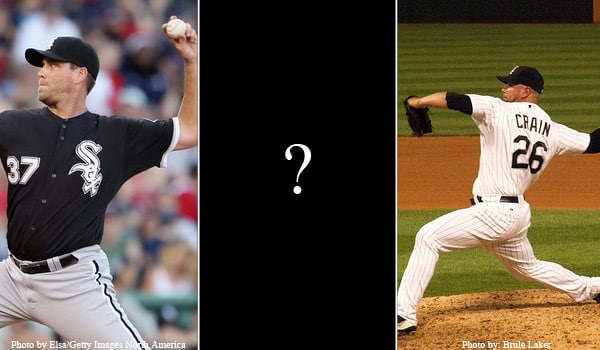 Many White Sox fans including myself are wondering who’s going to be the closer for the 2012 season. Will it be a platoon, or will the newly anointed manager stick with one guy for the whole season?
Many White Sox fans including myself are wondering who’s going to be the closer for the 2012 season. Will it be a platoon, or will the newly anointed manager stick with one guy for the whole season?
I thought I would take a moment to take a look at the potential White Sox closers and see who, statistically, would be the best hurler to close out some of the 73 games the Sox are going to win this year.
Note that I will only be comparing Thornton and Crain since Reed only had 6 games in the big leagues (though, Reed’s stuff was impressive). I will be comparing the two by taking a look at some advanced metrics.
Anyway, here we go.
One of the more intriguing pitching metrics that is a great gauge of a pitcher is xERA. Basically, this is what a pitcher’s ERA should be when you take away situation-dependent factors; it is measured primarily on the pitcher’s skill alone. And any pitcher who’s actual ERA varies greatly from the xERA, you can expect a major swing. xERA is a stat created by baseballhq.com.
For example, Jered Weaver’s xERA was about 1.27 points higher than his ERA last year. While at times he had elite stuff, this tells me he got pretty lucky most of the time. He got a lot of help from a high rate of runners being stranded on base, a low home-run-per-fly-ball rate and some other factors. Not to mention, his ground ball percentage was a poor 32% (with a 49% fly ball rate) in 2011, which means the home runs against him (read: an increase in ERA) are coming.
MATT THORNTON
Between 2008 and 2010, Thornton sported a 2.67, 2.74, 2.67 ERA with a 2.69, 2.91, 2.76 xERA; pretty damn impressive if you ask me. 2011 appeared to be an aberration of sorts with a 3.32 ERA and a 3.12 xERA (still really good stuff). The problem is Thornton is 35 and well past the prime of MLB players. Was 2011 the start of his downward trend, or does he have another good year or two left in him? Let’s look at some other stats that may provide the answer to that question.
Between 2008 and 2011, Thornton’s ground ball percentages were: 53%, 46%, 40%, and 49%. Anything around 50% is really good. So, he still seems to be effective in that regard.
However, his K/9, and K/BB have dropped drastically and his BB/9 went up a bit in 2011. In 2010, Thornton’s K/9 was at a ridiculous 12.0; and in the years before it hovered around 10.5. In 2011, this dropped to 9.5. Still good numbers, but showing signs of decline. Between 08-10, he also had about 4.2 strike-outs for every walk. In 2011, this dropped noticeably to 3. This is evidenced by an increase in WHIP from 1.01 in to 2010 to 1.36 in 2011.
Not a good sign.
But, Thornton completely dominated in July of 2011 and was stellar the remaining months. Despite the decline in numbers, they’re still pretty darn good numbers. I still feel that he has at least one or two good years left in him, as a set-up guy.
JESSIE CRAIN
From Ron Shandler’s 2012 Baseball Forecaster:
Two years of ERA gains coincide with developing ability to control both LHB and RHB. Now has four straight years of [K/9] growth, although weakening [BB/9] has prevented those gains from translating to [K/BB]. He’s concurrently turning GB into FB, with effects seen in HR/9 trend. xERA say he [is]…short of closer-worthiness.1
Numbers don’t lie, but is he really short of closer-worthiness?
Absolutely.
In 2011, his ground-ball rate was a low 33% and in 65 innings pitched, gave up 1 home run per 9 innings (and almost 10% home-run-per-fly-ball rate). This is not a trend you want to see in your closer.
His 2011 ERA was 2.62, but his xERA was 3.79: a drastic difference. This screams of a correction coming. Though, in the last 5 years, his xERA never dropped below 4.08, so his skills seem to be improving.
But this begs the question, “has he already reached his peak, or is there more improvement to come?”
Crain definitely showed some signs of improvement in 2011, but a 4.3 BB/9 is not acceptable closer material. he needs to get that BB/9 down considerably and that ground ball percentage way up before he can become a reliable closer.
The upside is Crain is 30, so he statistically should be hitting his prime; but the White Sox must also prepare for the fact that he may have hit his peak in 2011.
So, what is the conclusion?
The White Sox shouldn’t have got rid of Santos.*
* Though he doesn’t have a lot of innings under his belt, in 2011 Santos had a 43% ground ball rate, 13.1 K/9, 4.1 BB/9, and an ERA of 3.55, but a xERA of 2.61! He’s going to get better. And he’s only 28. Not to mention that slider is oh-so nasty.
1Ron Shandler. Ron Shandler’s 2012 Baseball Forecaster and Encyclopedia of Fanalytics. Triumph Books; 26 Annual Edition, December 20, 2011.
For More Great Chicago Sports Content
Get the latest Chicago sports news, analysis, and breaking stories on the Bears, Bulls, Blackhawks, Cubs, White Sox, Sky, and more! Tap the star to add us to your favorites on Google News, so you never miss a story on your favorite Chicago teams.
Follow us on Twitter at @chicitysports23 for more great content. We appreciate you taking time to read our articles. To interact more with our community and keep up to date on the latest in Chicago sports news, JOIN OUR FREE FACEBOOK GROUP by CLICKING HERE




